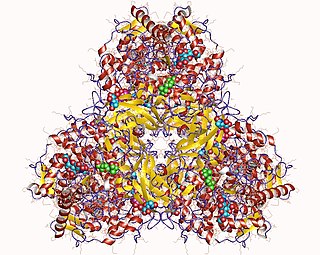Related Research Articles
A glucan is a polysaccharide derived from D-glucose, linked by glycosidic bonds. Glucans are noted in two forms: alpha glucans and beta glucans. Many beta-glucans are medically important. They represent a drug target for antifungal medications of the echinocandin class.

Glucan 1,4-α-glucosidase is an enzyme located on the brush border of the small intestine with systematic name 4-α-D-glucan glucohydrolase. It catalyses the following chemical reaction

Curdlan is a water-insoluble linear beta-1,3-glucan, a high-molecular-weight polymer of glucose. Curdlan consists of β-(1,3)-linked glucose residues and forms elastic gels upon heating in aqueous suspension. It was reported to be produced by Alcaligenes faecalis var. myxogenes. Subsequently, the taxonomy of this non-pathogenic curdlan-producing bacterium has been reclassified as Agrobacterium species.
In enzymology, a gluconate 2-dehydrogenase (EC 1.1.1.215) is an enzyme that catalyzes the chemical reaction
In enzymology, a secondary-alcohol oxidase (EC 1.1.3.18) is an enzyme that catalyzes the chemical reaction

Amine oxidase (copper-containing) (AOC) (EC 1.4.3.21 and EC 1.4.3.22; formerly EC 1.4.3.6) is a family of amine oxidase enzymes which includes both primary-amine oxidase and diamine oxidase; these enzymes catalyze the oxidation of a wide range of biogenic amines including many neurotransmitters, histamine and xenobiotic amines. They act as a disulphide-linked homodimer. They catalyse the oxidation of primary amines to aldehydes, with the subsequent release of ammonia and hydrogen peroxide, which requires one copper ion per subunit and topaquinone as cofactor:
The enzyme inulin fructotransferase (DFA-I-forming) catalyzes the following process:
In enzymology, a glycyrrhizinate β-glucuronidase (EC 3.2.1.128) is an enzyme that catalyzes the chemical reaction
The enzyme protein-glucosylgalactosylhydroxylysine glucosidase (EC 3.2.1.107) catalyzes the following chemical reaction:

Glucanases are enzymes that break down large polysaccharides via hydrolysis. The product of the hydrolysis reaction is called a glucan, a linear polysaccharide made of up to 1200 glucose monomers, held together with glycosidic bonds. Glucans are abundant in the endosperm cell walls of cereals such as barley, rye, sorghum, rice, and wheat. Glucanases are also referred to as lichenases, hydrolases, glycosidases, glycosyl hydrolases, and/or laminarinases. Many types of glucanases share similar amino acid sequences but vastly different substrates. Of the known endo-glucanases, 1,3-1,4-β-glucanase is considered the most active.
Amylo-α-1,6-glucosidase is an enzyme with systematic name glycogen phosphorylase-limit dextrin 6-α-glucohydrolase. It catalyses the hydrolysis of unsubstituted glucose units in glycogen linked by α(1→6) bonds to α(1→4)glucose chains.

Glucan 1,3-β-glucosidase is an enzyme with systematic name 3-β-D-glucan glucohydrolase. It catalyses the successive hydrolysis of β-D-glucose units from the non-reducing ends of (1→3)-β-D-glucans, releasing α-glucose.
The enzyme glucan 1,4-β-glucosidase, also known as 4-β-D-glucan glucohydrolase, catalyses the hydrolysis of (1→4)-linkages in 1,4-β-D-glucans and related oligosaccharides, removing successive glucose units.
Glucan endo-1,6-β-glucosidase is an enzyme with systematic name 6-β-D-glucan glucanohydrolase. It catalyses random hydrolysis of (1→6)-linkages in (1→6)-β-D-glucans
Glucan 1,3-α-glucosidase is an enzyme with systematic name 3-α-D-glucan 3-glucohydrolase. It catalyses the hydrolysis of terminal (1→3)-α-D-glucosidic links in (1→3)-α-D-glucans.
Arabinogalactan endo-β-1,4-galactanase is an enzyme with systematic name arabinogalactan 4-β-D-galactanohydrolase. It specifically catalyses the hydrolysis (1→4)-β-D-galactosidic linkages in type I arabinogalactans.
Glucan 1,6-α-isomaltosidase is an enzyme with systematic name 6-α-D-glucan isomaltohydrolase. It catalyses hydrolysis of (1→6)-β-D-glucosidic linkages in polysaccharides, to remove successive isomaltose units from the non-reducing ends of the chains
Branched-dextran exo-1,2-α-glucosidase is an enzyme with systematic name (1→2)-α-D-glucosyl-branched-dextran 2-glucohydrolase. It catalyses the hydrolysis of (1→2)-α-D-glucosidic linkages at the branch points of dextrans and related polysaccharides, producing free D-glucose.
Galactan endo-1,6-beta-galactosidase is an enzyme with systematic name endo-beta-(1->6)-galactanase. This enzyme catalyses the following chemical reaction
Scytalidopepsin A (EC 3.4.23.31, Scytalidium aspartic proteinase A, Scytalidium lignicolum aspartic proteinase, Scytalidium lignicolum aspartic proteinase A-2, Scytalidium lignicolum aspartic proteinase A-I, Scytalidium lignicolum aspartic proteinase C, Scytalidium lignicolum carboxyl proteinase, Scytalidium lignicolum acid proteinase) is an enzyme. This enzyme catalyses the following chemical reaction
References
- ↑ Ohya T, Sawai T, Uemura S, Abe K (1978). "Some catalytic properties of an exo-1,6-α-glucosidase (glucodextranase) from Arthrobacter globiformis I42". Agric. Biol. Chem. 42 (3): 571–577. doi: 10.1271/bbb1961.42.571 .
- ↑ Sawai T, Yamaki T, Ohya T (1976). "Preparation and some properties of Arthrobacter globiformis exo-1,6-α-glucosidase". Agric. Biol. Chem. 40: 1293–1299. doi: 10.1271/bbb1961.40.1293 .
- ↑ Walker GJ, Pulkownik A (July 1973). "Degradation of dextrans by an α-1,6-glucan glucohydrolase from Streptococcus mitis". Carbohydrate Research. 29 (1): 1–14. doi:10.1016/s0008-6215(00)82066-2. PMID 4356399.